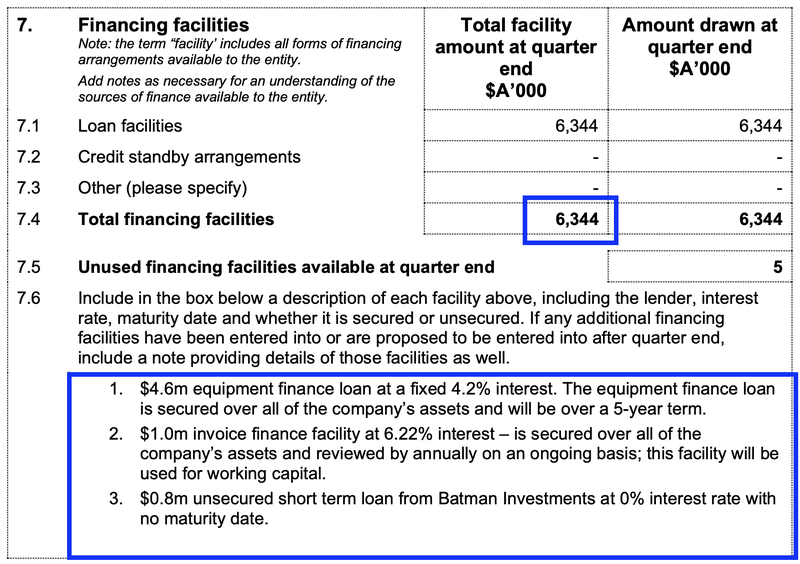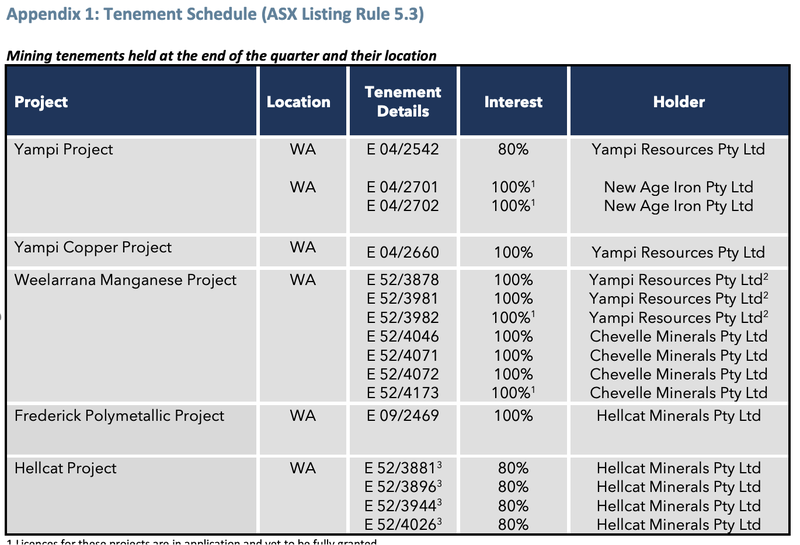How we like to read small cap quarterly 4C reports
Published 23-AUG-2023 11:09 A.M.
|
9 minute read
Ever look at a company’s quarterly report and not know what’s good and bad?
Well, in this educational article we will cover all of the details that you will need to know to understand quarterly reports.
What is a quarterly 4C report?
A quarterly report is a report published by public companies every quarter that details:
- The key activities that the company undertook that quarter;
- A comment from the CEO about the progress of the company;
- Revenue or sales numbers for the company;
- An accompanying cash flow statement revealing the cash balance to investors
Quarterly reporting is part and parcel of being an ASX listed company.
The two most common formats are a quarterly activities report (5B) and a quarterly cash flow report (4C).
The quarterly report is due one month after the end of the quarter, so for the Jan-Mar quarter, the report is due on or before April 30th.
Some public companies choose to run conference calls and presentations when the report is published - also known as an “earnings call”.
This gives the companies a chance to explain in further detail about the activities for the quarter, as well as set investor expectations for the next quarter.
Quarterly reporting season is also known as “confession season”.
It is the moment of truth for any small cap company, giving the market an insight into how much cash the company actually has.
As investors in small cap stocks that are reliant on the capital markets to fund exploration and operations, the first thing we do when reading a quarterly report is scroll to the cash balance.
If the cash balance is relatively low, compared to the anticipated activities for the company going forward, we can start to assess whether or not the company will need to raise money soon.
There are other things that we look for in quarterly reports but the cash balance is the key piece of information we look for but more on that later...
Why cash balance is so important for small caps
Growth and success doesn’t happen overnight, and small caps often need to raise cash many times before they can join the big leagues.
A large portion of small cap companies will never make it.
Access to capital markets, i.e. getting money to be able to execute a business plan, is what makes small caps tick and lets them have a chance at growth.
As a result, small caps constantly need to prove themselves to potential sources of financing to secure money to build out their projects or grow their business.
Having a strong cash balance is vital to small caps’ ability to deliver success - without it everything grinds to a halt.
If the cash balance is relatively low, compared to the anticipated activities for the company going forward, we can start to assess whether or not the company will need to raise money soon.
Also, with a low cash balance the market may suspect a cap raise is coming, so there may not be much buying on-market for the stock (and typically more selling) because potential investors are anticipating a discounted capital raise.
This means share prices can drift sideways or fall until the capital is raised and the “fear of an upcoming cap raise” is removed.
Where to find cash balance and “cash burn” on a quarterly report
Small caps often have to raise capital to grow at a discount.
The timing of capital raise is often closely tied to the remaining cash balance a company has relative to the company’s cash burn.
Handy hint to spot an upcoming cap raise - if you want to see if a company is likely to raise cash soon, just go to their most recent quarterly “Appendix 4C” announcement and scroll to section 8 and find the line item titled “estimated quarters of funding available” and you will see how many quarters of funding management thinks it has left based on its current cash burn:

Typically if that number is very low, management also need to offer an explanation as to what is being done to address the funding shortfall - this is normally found right under that section:

If the number is less than 2 quarters... It's possible a cap raise is around the corner.
This doesn’t work every time as occasionally companies will get approached (even when they don’t need more cash) by strategic investors who want to build a position without buying on market.
The company will quickly take the strategic placement to shore up their cash balance.
It’s important to note that if the company raised the company BEFORE the quarterly report was published, but after the end of the quarter the funding number may be out of date.
What about the cash burn?
The cash burn can be found under section 1.9 and 2.6 of a quarterly report - which gives you a sense for how much money the small cap is using (or making). It’s always good to look at cash balance and cash burn together.

If the number is in parentheses this means the company spent that much cash on operating activities, if the number isn’t that is net money made from operating activities.
Understanding a company’s business model is important to understanding cash burn.
For mining exploration companies there may be one quarter where a large amount of capital is spent due to a big drilling event, whereas spending in the previous few quarters were relatively conservative due to a lack of activity.
Tech companies may have a new product launched or biotech companies may be undertaking a clinical trial - both of which cost more money than the regular cost of working capital generally spent by companies.
It’s important when assessing a company's cash position to evaluate what activities the company has coming up and whether the cash balance matches the expected expenditure of the company.
If the cash balance is low relative to the expected expenditure, then the company may be on the cusp of a capital raise.
Revenue / Sales for the quarter
Each quarter, public companies that generate revenue will announce sales figures to investors.
For companies in growth sectors, like tech, investors are looking for accelerated growth in sales.
There are two ways in which sales growth can be reported:
- % growth from the previous quarter (linear growth model); OR
- % growth from the same comparable quarter last year (cyclical growth model)
For companies that are reliant on large, lumpy contracts for revenue there can be multiple quarters of no revenue, with it all coming at once with one or two big deals.
The quarterly report allows companies to provide updates on the progress on types of deals and help set investor expectations on revenue.
Comment from management
Each quarterly report will include a comment from the managing director or CEO of the company.
You can generally tell how excited or apologetic the management sounds, which gives an indication of management’s enthusiasm for the company’s projects.
Sometimes, these comments can yield a juicy snippet of information for investors to sink their teeth into.
It may be in the form of updated forecasts about revenues, contracts, opportunities or project timelines - that may not have been known to the market previously.
It pays to pay attention to the management comments in the quarterly report, as it is one of the best ways that company CEOs can communicate enthusiasm about a project to investors.
Other details
There are some other useful details that you can find in the quarterly report including:
Small project updates
There may be smaller project updates that are included in the quarterly report like updated patient numbers in a clinical trial or new products that have been released to market.
These are non-market sensitive pieces of information that add to the overall company story.
Overdue news
If there is any overdue news, like assays to be reported, the company may choose to announce it in the quarterly report if the company does not think the results are material.
This often happens with companies in the ‘definition’ and ‘feasibility’ stage of the mining company life cycle - where the drilling is about growing the size of the resource rather than making a discovery.
Corporate Summary / Cap Table
There will often be a ‘corporate summary’ section in the quarterly report that details the company developments related to shares, options and performance rights.
When undertaking due diligence on a new company, this section is often a useful place to start to see what recent corporate activities have taken place for the company and if there had been any recent capital raises that may affect an investment decision.
Tenement schedule
Each company will publish a tenement schedule in the quarterly report (appendix 1).
This schedule shows which tenements the company owns, and more importantly, which ones the company doesn’t own.
If you invested in a company for a particular project and the company has gone quiet, it may have sold the tenaments for that project OR let them lapse.
This may affect your investment thesis, so it is important to quickly check the tenement schedule to make sure those tenements are still there.
Here is what a tenement schedule generally looks like:

Outstanding loans
In section 7 of the quarterly cash flow report “financing facilities”, the company will publish details about its outstanding loans:
This total amount includes all of the outstanding debt that the company owes to third parties, with the details outlined in 7.6.
This section is also really useful for undertaking due diligence on potential new investments as it allows investors to make an informed assessment of the company’s cash position (when you include the outstanding debts).
Conclusion: The value of quarterly reports
We think the quarterly reports are one of the most valuable sources of information for investors in public companies.
New information can be limited BUT the small bits of information can sometimes have relatively large impacts on the understanding of a company’s fundamentals.
As an investor, we try to at least scan through the quarterly report for each of our companies, reading through the management comments.
But the most useful part of every quarterly report for small caps is the cash balance reported, so that we can make an informed guess about when to expect a capital raise announced by the company.
General Information Only
S3 Consortium Pty Ltd (S3, ‘we’, ‘us’, ‘our’) (CAR No. 433913) is a corporate authorised representative of LeMessurier Securities Pty Ltd (AFSL No. 296877). The information contained in this article is general information and is for informational purposes only. Any advice is general advice only. Any advice contained in this article does not constitute personal advice and S3 has not taken into consideration your personal objectives, financial situation or needs. Please seek your own independent professional advice before making any financial investment decision. Those persons acting upon information contained in this article do so entirely at their own risk.
Conflicts of Interest Notice
S3 and its associated entities may hold investments in companies featured in its articles, including through being paid in the securities of the companies we provide commentary on. We disclose the securities held in relation to a particular company that we provide commentary on. Refer to our Disclosure Policy for information on our self-imposed trading blackouts, hold conditions and de-risking (sell conditions) which seek to mitigate against any potential conflicts of interest.
Publication Notice and Disclaimer
The information contained in this article is current as at the publication date. At the time of publishing, the information contained in this article is based on sources which are available in the public domain that we consider to be reliable, and our own analysis of those sources. The views of the author may not reflect the views of the AFSL holder. Any decision by you to purchase securities in the companies featured in this article should be done so after you have sought your own independent professional advice regarding this information and made your own inquiries as to the validity of any information in this article.
Any forward-looking statements contained in this article are not guarantees or predictions of future performance, and involve known and unknown risks, uncertainties and other factors, many of which are beyond our control, and which may cause actual results or performance of companies featured to differ materially from those expressed in the statements contained in this article. S3 cannot and does not give any assurance that the results or performance expressed or implied by any forward-looking statements contained in this article will actually occur and readers are cautioned not to put undue reliance on forward-looking statements.
This article may include references to our past investing performance. Past performance is not a reliable indicator of our future investing performance.



